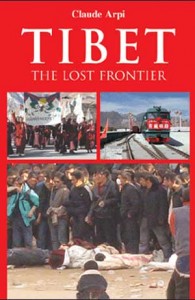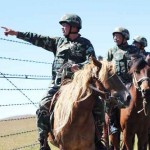The British clearly identified three main obstacles to their Tibetan forward policy and an eventual alliance with Lhasa.
The first problem was the antagonism of the Himalayan countries such as Bhutan and Nepal towards the Crown. They felt culturally closer to Tibet than to the British.
| Editor’s Pick |
The second problem was the presence of the Manchu Emperors (through their Ambans) in Lhasa. We have earlier seen the extreme weakness of the Tibetan system and their military dependence on their Chinese patron.
The third obstacle Bogle identified was the growing influence and presence of Russia in the area. One hundred and thirty years later, the same argument (or pretext?) led Lord Curzon, the Viceroy, to send Colonel Younghusband to Tibet, to establish by military means the ‘forward policy’ envisioned by Hastings.
Turner again proposed an agreement to the Tibetans and although the Tashi Lhunpo was not against trading with the British, it was refused again by the Regent in Lhasa under the Ambans influence.
The next occasion for the British to penetrate Tibet came in 1782 when a British Captain, Samuel Turner visited Shigatse. He described the relations between the Tibetans and the Chinese thus: “The influence of the Chinese overawes the Tibetans in all their proceedings, and produces a timidity and a caution in their conduct more suited to the character of subjects than allies.”
Turner again proposed an agreement to the Tibetans and although the Tashi Lhunpo was not against trading with the British, it was refused again by the Regent in Lhasa under the Amban’s influence. The ‘timidity and caution’ of the Tibetan leaders had prevailed.
For a few years the forward policy of the British Empire remained at a standstill. It was only in 1810, that Lord Minto, the Viceroy, sent a new Mission to Tibet led by Thomas Manning, a reputed scholar.
Manning stayed in Lhasa for many months but was finally recalled by the Viceroy. He seems to have been so disgusted by the attitude of the British Government which had not given him the support he felt it should have, that on his return to India in June 1812, he did not even make an official report about his journey. Manning was to be the last Englishman to enter Lhasa before the troops of Younghusband in 1904.
Again and again, British field officers would not receive London’s backing; the Foreign Office did not want to upset Chinese susceptibilities. It is true that at that time, London had plenty of other problems to deal with — in particular, the advance of Napoleon in Europe.
 Managing an empire on which ‘the sun never sets’, the Crown’s objectives were to become richer, open new markets, control more strategic positions and eventually bring the Pax Britannia to the world. While the objective of the Chinese Emperors was domination, that of the British was trade and London knew that it is easier to trade with friends than with enemies.
Managing an empire on which ‘the sun never sets’, the Crown’s objectives were to become richer, open new markets, control more strategic positions and eventually bring the Pax Britannia to the world. While the objective of the Chinese Emperors was domination, that of the British was trade and London knew that it is easier to trade with friends than with enemies.
British India and the Himalayan Kingdoms
Great Britain started tackling the problems enunciated by Bogle one by one; time was in their favour. They dealt first with Nepal.
In 1814, a British expedition with 34,000 soldiers annexed Nepal. Ten years later the British made the next move and marched into Assam. The Company’s territory now had a border with Bhutan and ultimately in 1865, the British attacked Bhutan, which became a Protectorate.
London used this delay to plan its future strategy. The collateral of this rather small dispute was a new treaty between the British and the Manchu Government regarding Sikkim and Tibet.
Next on the Viceroy’s map was the Kingdom of Sikkim. The annexation of Sikkim or at least control over it by the British was of prime strategic importance: the Chumbi valley commanded the entrance into Tibet.
For centuries the major trade route between India and Central Tibet passed through Natu-la,8 Yatung in Chumbi Valley and then onto Gyantse in Tibet. From a military point of view also, the control of Gangtok and Natu-la was most important.
All the pawns were in place. Nothing would stop the opening of a trade route between India and Tibet, once the suzerainty of Sikkim was grabbed from Lhasa by the British crown.
The ‘acquisition’ of Darjeeling was also a crucial stroke in their strategy and many English officers could already see the potential of Darjeeling as a turning point for trade and diplomatic manoeuvres in the Himalayan region. Similar views were held about Kalimpong. In Tibet, there was an increasing uneasiness over the British ‘Forward Policy’, but what could be done?
The masters of the moment were the British and they were rather benevolent masters. The Sikkimese had to accept their fate in good spirit and there were already many in the kingdom who were ready to collaborate with the Crown. Is it not better to have a benevolent master than a malevolent one?
“¦would have very serious repercussions on the political relations among India, China and Tibet during the following twenty years.
In Tibet, it was different. The Government had never dealt with a Western power and the Tibetans knew very little about modern warfare and the latest technologies used by the British army. They knew even less about diplomacy.
In 1886, an incident occurred between the British, now de facto if not de lego suzerain over Sikkim, and the Tibetans.
It started with a (well founded) rumour that the Viceroy, Randolf Churchill was planning to send a commercial mission to Shigatse without the permission of Lhasa. This created a lot of resentment in Tibet and Lhasa decided to send some 200 soldiers to the Sikkimese border to block the way of the proposed mission.
Around the same time yet another irritant emerged: the Tibetans heard in 1876 that the British had signed an Agreement with the Chinese in Chefoo. Though the Government in Lhasa had not been consulted or even informed, one of the clauses concerned Tibet. The British scheme was to pass the Treaty through the back door: as they had not been able to reach Tibet from the South, they would do it through the West. They secured the permission of the Chinese to send a mission to Tibet through the mainland.
Tempers ran so high in Lhasa that the Tsongdu,9 at an emergency meeting, decided to take an oath never to allow the British to enter Tibetan territory. The National Assembly’s seal was put on the oath. It also declared that the Chinese Emperor had no power to give passports permitting foreigners to enter Tibetan territory.
The British scheme was to pass the Treaty through the back door: as they had not been able to reach Tibet from the South, they would do it through the West. They secured the permission of the Chinese to send a mission to Tibet through the mainland.
In the meantime, the Kashag was informed that the British were planning to build a guest-house on the border between Sikkim and Tibet, near the border pass of Jelap-la. Lhasa resolved to send two Representatives to find out where the border was and to set up a check-post to guard it. The border had never been properly demarcated.
Finally, in 1887, a fortified post was built by the Tibetans in Lungthur which according them, was inside their territory. Unfortunately the British did not agree with the demarcations and demanded their immediate removal.
An ultimatum was sent to the Tibetan commanders to vacate their fortifications before March 15, 1888. At the same time the British sent a formal protest10 which was forwarded to the Manchus and the Dalai Lama by the Choegyal of Sikkim.




